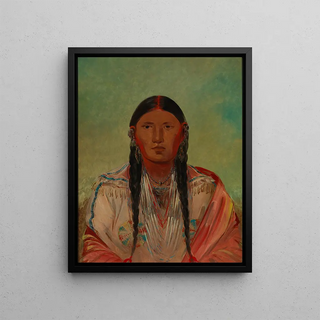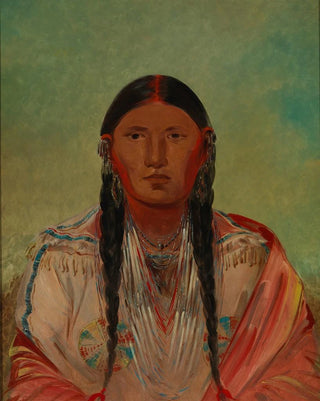Art print | Ru-Ton-Wee-Me Pigeon sur l'aile - George Catlin


View from behind

Frame (optional)
In the vast panorama of American art history, the art print "Ru-Ton-Wee-Me Pigeon sur l'aile" by George Catlin stands out for its ability to capture the very essence of nature and the traditions of indigenous peoples. Catlin, as a painter and ethnographer, skillfully combined his artistic talent with a deep understanding of the cultures he encountered. This piece, both delicate and powerful, invites us to immerse ourselves in a universe where the beauty of wildlife and the richness of human traditions intersect. The art print of this iconic work allows for appreciation not only of the artist's technique but also of the cultural significance surrounding it.
Style and uniqueness of the art print
George Catlin's style is characterized by meticulous attention to detail and a vibrant color palette that evoke wild life and American landscapes. In "Ru-Ton-Wee-Me Pigeon sur l'aile," the artist highlights a pigeon, a symbol of peace and serenity, while incorporating elements that emphasize the links between man and nature. This piece does not merely depict a bird; it tells a story, that of harmonious coexistence between peoples and their environment. The composition is carefully balanced, each brushstroke demonstrating Catlin's skill in capturing the movement and grace of the animal, while anchoring its subject within a rich cultural context. The art print of this work allows rediscovery of the finesse of his line and the depth of his message.
The artist and his influence
George Catlin, born in 1796, is often regarded as one of the pioneers of landscape painting and the representation of Native American cultures. His travels across the American continent enabled him to meet numerous tribes, whose customs, rituals, and landscapes he faithfully depicted. Catlin was a passionate advocate for the preservation of indigenous cultures, and his work serves as a valuable testimony of an era when these traditions were under threat. His unique style has inspired many artists and paved the way for a new appreciation of Native American art.

Matte finish

View from behind

Frame (optional)
In the vast panorama of American art history, the art print "Ru-Ton-Wee-Me Pigeon sur l'aile" by George Catlin stands out for its ability to capture the very essence of nature and the traditions of indigenous peoples. Catlin, as a painter and ethnographer, skillfully combined his artistic talent with a deep understanding of the cultures he encountered. This piece, both delicate and powerful, invites us to immerse ourselves in a universe where the beauty of wildlife and the richness of human traditions intersect. The art print of this iconic work allows for appreciation not only of the artist's technique but also of the cultural significance surrounding it.
Style and uniqueness of the art print
George Catlin's style is characterized by meticulous attention to detail and a vibrant color palette that evoke wild life and American landscapes. In "Ru-Ton-Wee-Me Pigeon sur l'aile," the artist highlights a pigeon, a symbol of peace and serenity, while incorporating elements that emphasize the links between man and nature. This piece does not merely depict a bird; it tells a story, that of harmonious coexistence between peoples and their environment. The composition is carefully balanced, each brushstroke demonstrating Catlin's skill in capturing the movement and grace of the animal, while anchoring its subject within a rich cultural context. The art print of this work allows rediscovery of the finesse of his line and the depth of his message.
The artist and his influence
George Catlin, born in 1796, is often regarded as one of the pioneers of landscape painting and the representation of Native American cultures. His travels across the American continent enabled him to meet numerous tribes, whose customs, rituals, and landscapes he faithfully depicted. Catlin was a passionate advocate for the preservation of indigenous cultures, and his work serves as a valuable testimony of an era when these traditions were under threat. His unique style has inspired many artists and paved the way for a new appreciation of Native American art.






